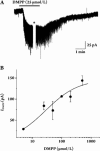Central cholinergic regulation of respiration: nicotinic receptors
- PMID: 19498418
- PMCID: PMC4002383
- DOI: 10.1038/aps.2009.88
Central cholinergic regulation of respiration: nicotinic receptors
Abstract
Nicotinic acetylcholine receptors (nAChRs) are expressed in brainstem and spinal cord regions involved in the control of breathing. These receptors mediate central cholinergic regulation of respiration and effects of the exogenous ligand nicotine on respiratory pattern. Activation of alpha4* nAChRs in the preBötzinger Complex (preBötC), an essential site for normal respiratory rhythm generation in mammals, modulates excitatory glutamatergic neurotransmission and depolarizes preBötC inspiratory neurons, leading to increases in respiratory frequency. nAChRs are also present in motor nuclei innervating respiratory muscles. Activation of post- and/or extra-synaptic alpha4* nAChRs on hypoglossal (XII) motoneurons depolarizes these neurons, potentiating tonic and respiratory-related rhythmic activity. As perinatal nicotine exposure may contribute to the pathogenesis of sudden infant death syndrome (SIDS), we discuss the effects of perinatal nicotine exposure on development of the cholinergic and other neurotransmitter systems involved in control of breathing. Advances in understanding of the mechanisms underlying central cholinergic/nicotinic modulation of respiration provide a pharmacological basis for exploiting nAChRs as therapeutic targets for neurological disorders related to neural control of breathing such as sleep apnea and SIDS.
Figures




Similar articles
-
Alpha4* nicotinic receptors in preBotzinger complex mediate cholinergic/nicotinic modulation of respiratory rhythm.J Neurosci. 2008 Jan 9;28(2):519-28. doi: 10.1523/JNEUROSCI.3666-07.2008. J Neurosci. 2008. PMID: 18184794 Free PMC article.
-
Mechanisms underlying regulation of respiratory pattern by nicotine in preBötzinger complex.J Neurophysiol. 2001 Jun;85(6):2461-7. doi: 10.1152/jn.2001.85.6.2461. J Neurophysiol. 2001. PMID: 11387392 Free PMC article.
-
Pharmacology of nicotinic receptors in preBötzinger complex that mediate modulation of respiratory pattern.J Neurophysiol. 2002 Oct;88(4):1851-8. doi: 10.1152/jn.2002.88.4.1851. J Neurophysiol. 2002. PMID: 12364511 Free PMC article.
-
Neural circuits and nicotinic acetylcholine receptors mediate the cholinergic regulation of midbrain dopaminergic neurons and nicotine dependence.Acta Pharmacol Sin. 2020 Jan;41(1):1-9. doi: 10.1038/s41401-019-0299-4. Epub 2019 Sep 25. Acta Pharmacol Sin. 2020. PMID: 31554960 Free PMC article. Review.
-
Impact of Prenatal Nicotine Exposure on Placental Function and Respiratory Neural Network Development.Adv Exp Med Biol. 2023;1428:233-244. doi: 10.1007/978-3-031-32554-0_10. Adv Exp Med Biol. 2023. PMID: 37466776 Review.
Cited by
-
Cholinergic neurons in the pedunculopontine tegmental nucleus modulate breathing in rats by direct projections to the retrotrapezoid nucleus.J Physiol. 2019 Apr;597(7):1919-1934. doi: 10.1113/JP277617. Epub 2019 Mar 1. J Physiol. 2019. PMID: 30724347 Free PMC article.
-
Increased central cholinergic drive contributes to the apneas of serotonin-deficient rat pups during active sleep.J Appl Physiol (1985). 2019 May 1;126(5):1175-1183. doi: 10.1152/japplphysiol.00909.2018. Epub 2019 Feb 14. J Appl Physiol (1985). 2019. PMID: 30763168 Free PMC article.
-
Molecular characterization of frog vocal neurons using constellation pharmacology.J Neurophysiol. 2020 Jun 1;123(6):2297-2310. doi: 10.1152/jn.00105.2020. Epub 2020 May 6. J Neurophysiol. 2020. PMID: 32374212 Free PMC article.
-
Mechanisms of Organophosphate Toxicity and the Role of Acetylcholinesterase Inhibition.Toxics. 2023 Oct 18;11(10):866. doi: 10.3390/toxics11100866. Toxics. 2023. PMID: 37888716 Free PMC article. Review.
-
Developmental nicotine exposure alters cholinergic control of respiratory frequency in neonatal rats.Dev Neurobiol. 2016 Oct;76(10):1138-49. doi: 10.1002/dneu.22380. Epub 2016 Feb 17. Dev Neurobiol. 2016. PMID: 26818254 Free PMC article.
References
-
- Gesell R, Hansen E, Worzniak J. Humoral intermediation of nerve cell activation in the central nervous system. Am J Physiol. 1943;138:776–91.
-
- Metz B. Correlation between respiratory reflex and acetylcholine content of pons and medulla. Am J Physiol. 1962;202:80–2. - PubMed
-
- Wiemer W. On the effect of acetylcholine on respiration. IV. Effect following injection into the cisterna pontis, cisterna cerebellomedullaris, lateral ventricles and cerebrospinal fluid. Pflugers Arch. 1963;276:568–78. - PubMed
-
- Brimblecombe RW.Drugs acting on central cholinergic mechanisms and affecting respiration In: Widdicombe JG editor. International Encyclopedia of Pharmacology and Therapeutics Section 104: respiratory Pharmacology. Oxford: Pergamon Press; 1981. p175–84. - PubMed
Publication types
MeSH terms
Substances
Grants and funding
LinkOut - more resources
Full Text Sources
Research Materials

